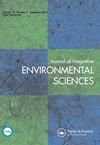边界的冲突:南非金门高地国家公园中与金门高地国家公园的金合欢相关的公园-社区冲突的评估
IF 3.5
4区 环境科学与生态学
Q3 ENVIRONMENTAL SCIENCES
Journal of Integrative Environmental Sciences
Pub Date : 2016-01-02
DOI:10.1080/1943815X.2015.1130062
引用次数: 8
摘要
摘要本研究以“现实-世界观”为框架,考察了南非国家公园为保护环境完整性免受生物入侵而产生的公园-社区冲突。该研究利用遥感数据调查了公园北部边缘和邻近的公共牧区的植被覆盖状况,以确定两个地区之间植物资源禀赋的差异。该研究还包括对公园官员和当地社区关于金合欢入侵对环境影响的看法的调查反应进行歧视性分析,以及该物种如何传播以及如何控制该物种。本研究的目的是评估限制社区获取公园资源的举措所引起的公园与社区之间的冲突,以证明有必要防止黑毛猴入侵公园。研究得出的结论是,尽管人类和牲畜的不受控制的移动造成了物种入侵公园的明显危险,但物种被视为环境威胁的程度取决于利益相关者的“世界观”,只有通过谈判、环境意识和教育活动以及向交战各方提供解决冲突的培训,才能实现这一桥梁。本文章由计算机程序翻译,如有差异,请以英文原文为准。
Strifes of the frontier: an assessment of Acacia mearnsii related park-community conflicts in the Golden Gate Highlands National Park, South Africa
Abstract This study coins the “reality-worldview” framework to examine park-community conflicts arising from the expediency to protect the environmental integrity of a South African national park from bio-invasion. The study used remote sensing data to investigate the state of vegetation cover along the northern fringes of the park and an adjacent communal grazing area to determine differences in plant based resource endowments between the two areas. The study also involved the discriminant analysis of survey responses from park officials and local communities regarding perceptions about the environmental impacts of Acacia mearnsii invasion, as well as how the species spreads and how the species can be controlled. The objective of the study was to assess park-community conflicts arising from initiatives to limit community access to park resources on the justification of the need to prevent the invasion of the park by A. mearnsii. The study concludes that even though uncontrolled movement of people and livestock creates the obvious danger of invasion of the park by the species, the extent to which the species is viewed as an environmental threat depends on the “worldviews” of the stakeholders, the bridging of which can only be achieved through negotiation, environmental awareness and education campaigns and provision of training in conflict resolution to the belligerents.
求助全文
通过发布文献求助,成功后即可免费获取论文全文。
去求助
来源期刊

Journal of Integrative Environmental Sciences
ENVIRONMENTAL SCIENCES-
CiteScore
3.90
自引率
0.00%
发文量
13
审稿时长
>12 weeks
期刊介绍:
Journal of Integrative Environmental Sciences (JIES) provides a stimulating, informative and critical forum for intellectual debate on significant environmental issues. It brings together perspectives from a wide range of disciplines and methodologies in both the social and natural sciences in an effort to develop integrative knowledge about the processes responsible for environmental change. The Journal is especially concerned with the relationships between science, society and policy and one of its key aims is to advance understanding of the theory and practice of sustainable development.
 求助内容:
求助内容: 应助结果提醒方式:
应助结果提醒方式:


